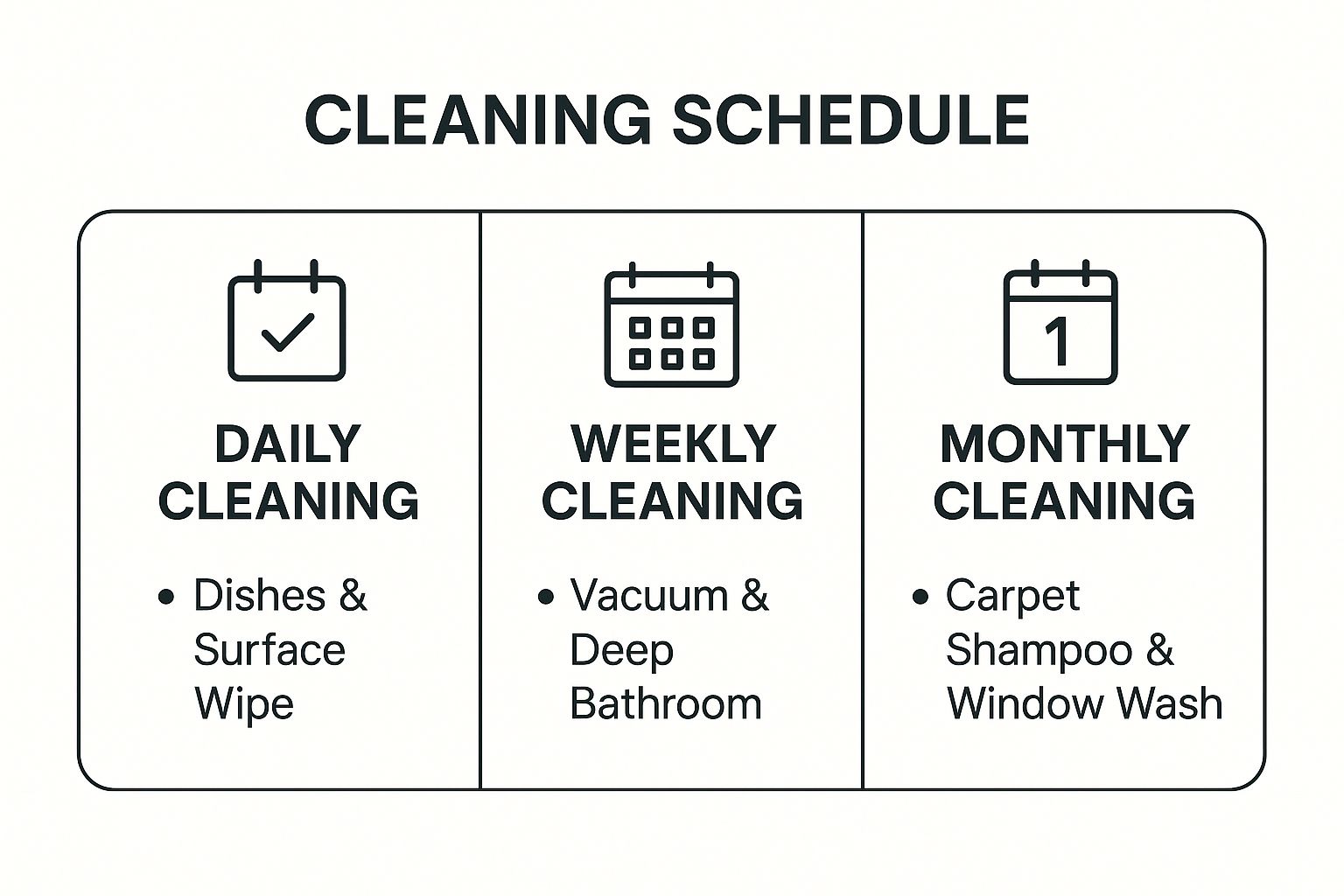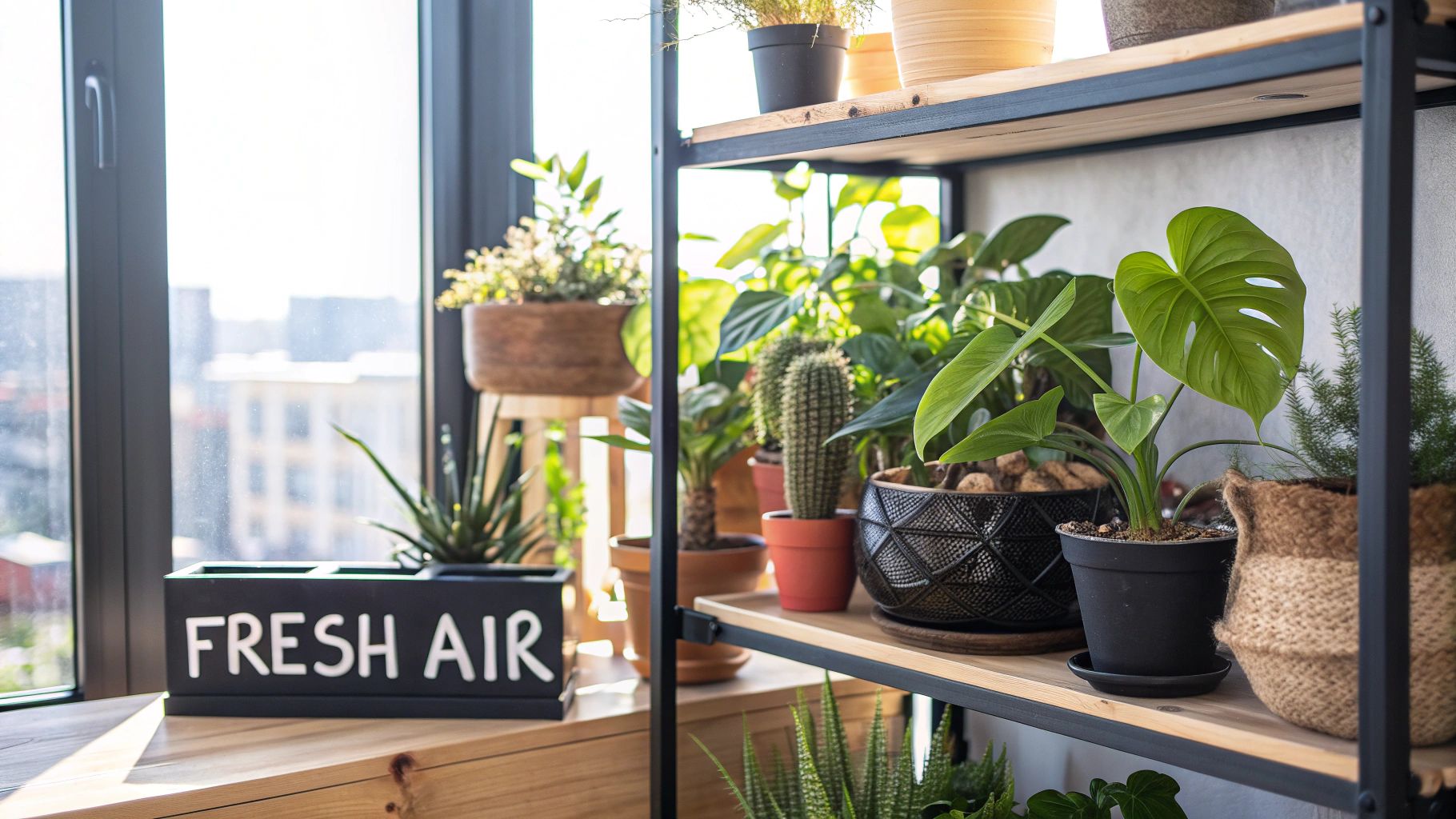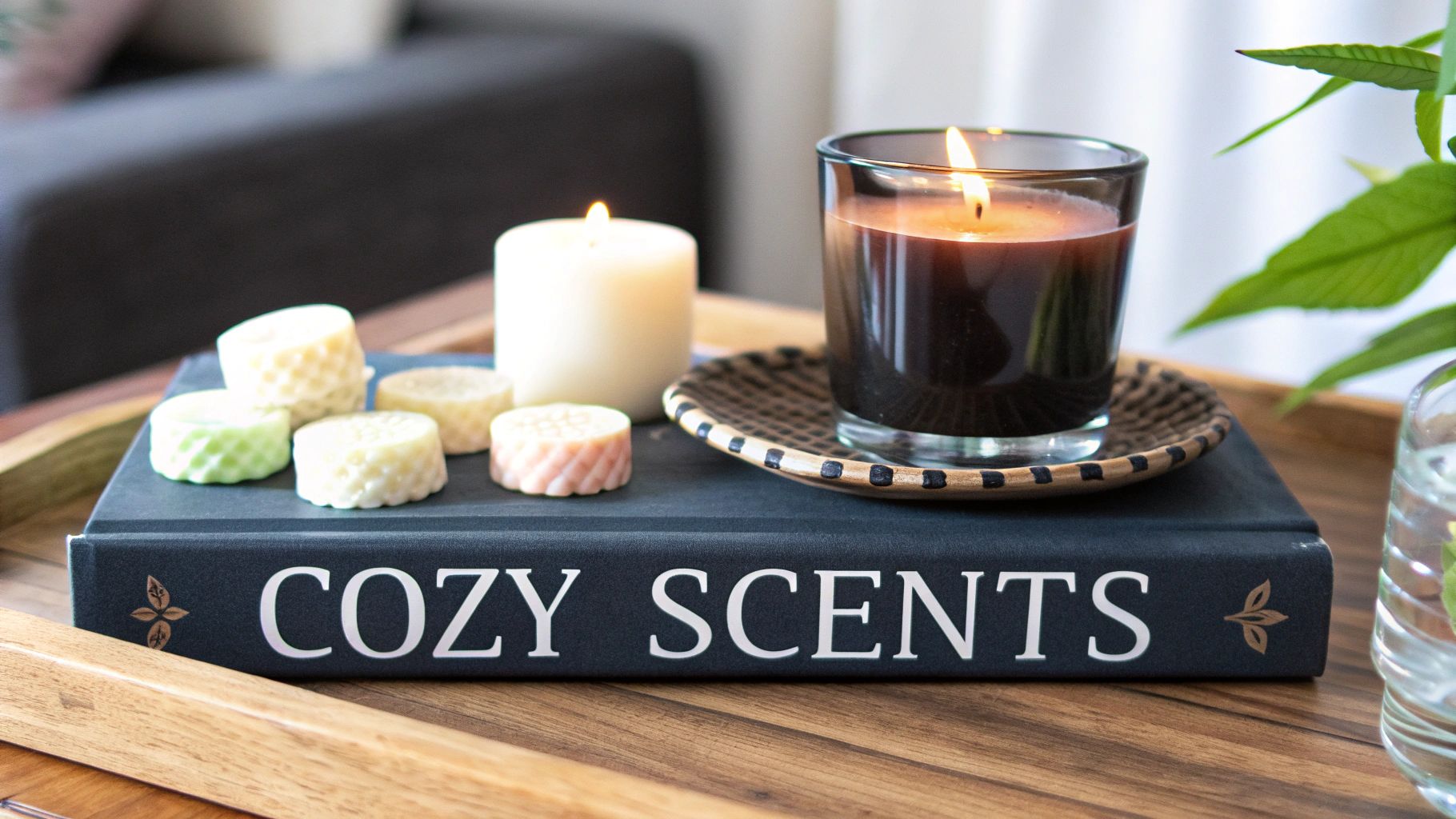8 Pro Tips on How to Make House Smell Good in 2025
Aug 02, 2025
Welcome to the definitive guide on transforming your living space into a sanctuary of delightful aromas. The quest for how to make house smell good is about more than just masking odors; it’s about crafting an atmosphere of comfort, luxury, and well-being. A pleasant scent is the first thing guests notice and the last thing you remember when you settle in for the night. It's a critical element that shapes the perception and feel of your entire home.
In this comprehensive roundup, we will explore expert-approved methods, from foundational deep-cleaning routines that eliminate unwanted smells at their source to the sophisticated elegance of luxury scent systems. We'll move beyond generic advice to provide actionable, step-by-step strategies that address the root cause of odors and layer in sophisticated fragrances, ensuring every room in your house smells consistently fresh and inviting. Get ready to elevate your home environment from simply clean to unforgettably aromatic.
To kick things off, see how a simple, elegant diffuser can instantly transform your space in this clip:
https://www.instagram.com/reel/C8etS9cuaui/
1. Start with the Source: The Power of Regular Deep Cleaning Routines
Before you can add luxurious scents to your home, you must first eliminate the sources of bad odors. Attempting to mask underlying smells with fragrances is like painting over a cracked wall; the problem remains underneath. The most effective strategy for how to make your house smell good begins with a systematic deep cleaning routine that targets the root causes of malodors.
This approach goes far beyond simple surface wiping. It involves actively removing the bacteria, mold, mildew, and trapped organic matter that fester in carpets, upholstery, and hidden crevices. By focusing on removal rather than covering up, you create a truly neutral canvas. This allows any fragrances you introduce, like those from an Airomatica diffuser, to shine without competing with stale or unpleasant background smells.
The Foundation of a Fresh Home
A genuinely clean home is the non-negotiable first step. Think of it like the meticulous deep cleaning protocols in hospitals or high-end restaurants, where sanitation is paramount. Professionals like Molly Maid and Stanley Steemer build their entire business model on this principle: true freshness comes from eliminating the source. This is why their services are so effective at transforming a home's atmosphere.
To implement this at home, adopt a multi-layered cleaning schedule.
- Immediate Action: Clean all spills, especially on porous surfaces like carpets or couches, the moment they happen. Use enzymatic cleaners for pet accidents, as they break down the organic proteins that cause lingering odors.
- Regular Maintenance: Wash soft furnishings like throw pillows, blankets, and curtains at least monthly, as they are notorious for trapping dust and smells.
- Periodic Deep Cleans: Commit to steam cleaning carpets every 6-12 months to remove embedded grime. Don't forget to clean your HVAC vents and change the filters regularly to prevent dust and mold from circulating throughout your home.
Key Insight: The goal isn't just a visually clean space, but an olfactorily neutral one. A deep clean removes the "scent baggage" that accumulates over time, making your home receptive to new, intentional fragrances.
This infographic breaks down a simple yet effective cleaning schedule into daily, weekly, and monthly tasks.

By integrating these targeted actions into your routine, you systematically eliminate odor sources before they become noticeable problems. This disciplined approach ensures your home's baseline scent is genuinely fresh, not just perfumed.
2. Natural Ventilation and Air Circulation
Once your home is deeply cleaned, the next step in how to make your house smell good is to embrace the elemental power of fresh air. Natural ventilation is a timeless, zero-cost method for expelling stale, trapped indoor air and replacing it with clean, crisp outdoor air. This isn't just about leaving a window cracked; it’s a strategic practice of creating airflow that actively purges lingering cooking smells, pet dander, and stagnant odors.
This method works by harnessing natural pressure differentials and creating cross-breezes. Think of it as a reset button for your home's atmosphere. By systematically flushing out the old air, you prevent the buildup of airborne pollutants and odor molecules. This creates a more vibrant and healthy indoor environment, ensuring that when you do introduce a scent, such as one from an Airomatica diffuser, it can fill the space without being diluted by mustiness.
The Foundation of a Fresh Atmosphere
Strategic ventilation is a core principle in architecture, from traditional Japanese homes with their sliding shoji screens to modern green buildings certified by ASHRAE. These designs prioritize air exchange because they recognize that a constant flow of fresh air is fundamental to a healthy and pleasant living space. You can replicate this professional-grade air quality management in your own home with simple, daily habits.
To effectively implement this, focus on creating clear pathways for air to travel.
- Create Cross-Breezes: Open windows on opposite sides of your home or room for 10-15 minutes. This allows fresh air to enter from one side and push stale air out the other, creating a powerful flushing effect.
- Use Exhaust Fans: Always run your kitchen and bathroom exhaust fans during and for at least 10-15 minutes after cooking or showering. This directly captures and removes concentrated sources of steam, smoke, and odors before they can spread.
- Time it Right: The best times to ventilate are typically in the early morning or evening when the outside air is cooler and fresher. This daily exchange prevents odors from settling into your home’s surfaces.
Key Insight: Consistent air exchange is a preventative measure. Instead of letting odors accumulate and become a problem, you are actively removing them on a daily basis, maintaining a constant state of freshness that cleaning alone cannot achieve.
By making tactical ventilation a part of your daily rhythm, you ensure the air inside your home is as clean and neutral as the surfaces. This dynamic approach complements your cleaning routine and sets the perfect stage for introducing sophisticated, intentional fragrances.
3. Houseplants for Air Purification
Beyond simple decor, strategically placed indoor plants act as living air purifiers, naturally filtering out pollutants and releasing fresh oxygen. This biological approach to how to make your house smell good tackles poor air quality at its source. Research, most notably NASA's Clean Air Study, has identified specific houseplants that excel at removing common household toxins like formaldehyde, benzene, and trichloroethylene, which often contribute to stale or chemical-like odors.
This method introduces a subtle, earthy freshness that manufactured scents cannot replicate. While a single plant won't transform your home overnight, a collection of them works continuously to scrub the air. This creates a healthier and more pleasant baseline atmosphere, allowing nuanced fragrances from other sources, such as a high-quality diffuser, to be appreciated without competing with stagnant air.

The Foundation of a Fresh Home
Living greenery is a cornerstone of biophilic design, a concept used by companies like Google and Amazon in their plant-filled offices and Spheres to improve employee well-being and air quality. The principle, popularized by figures like Dr. Bill Wolverton of the NASA study and Kamal Meattle in his influential TED Talk, is that plants are the planet's natural lungs. Bringing them indoors leverages this powerful, self-sustaining system.
To effectively implement this strategy, focus on placement and plant selection.
- Strategic Placement: A general rule of thumb is to place at least one medium-sized plant per 100 square feet. Focus on rooms where you spend the most time, such as living rooms and bedrooms.
- Best Plant Choices: Opt for proven air-purifying champions like Snake Plants, Peace Lilies, Spider Plants, and Pothos. Many of these are hardy and thrive in lower-light conditions, making them ideal for various indoor environments.
- Maintenance for Efficacy: Gently wipe down the leaves with a damp cloth monthly. Dust accumulation can clog the plant's stomata (pores), reducing its ability to filter air effectively.
Key Insight: Houseplants do more than just beautify a space; they are functional, silent workers that actively improve air quality. Their contribution creates a foundation of natural freshness that enhances any other scenting strategy you employ.
By incorporating these botanical powerhouses into your home, you are not just decorating. You are installing a natural, sustainable air filtration system that works around the clock to keep your home smelling genuinely clean and vibrant.
4. Embrace Passive Elegance: The Art of Reed Diffusers
For those seeking a continuous, subtle fragrance without the need for heat, electricity, or active management, reed diffusers offer an elegant solution. This passive diffusion system uses natural rattan reeds to absorb scented oil from a vessel and gently release it into the air. It’s a timeless method for how to make your house smell good with minimal effort and maximum aesthetic appeal.
This approach works through capillary action, where the porous reeds act as wicks, drawing the fragrance oil upward. The scent then evaporates from the reed surfaces, subtly scenting the surrounding space. Unlike plugins or sprays that can be overwhelming, reed diffusers provide a consistent, low-intensity background aroma. This makes them ideal for smaller, more intimate areas like bathrooms, home offices, or entryways where you want a welcoming but not overpowering scent.
The Foundation of Effortless Scent
The beauty of a reed diffuser lies in its simplicity and decorative quality. High-end brands like Diptyque and Nest Fragrances have perfected this, turning a simple fragrance tool into a statement piece you’d find in luxury hotel lobbies and upscale boutiques. The key is using high-quality reeds and fragrance oils that ensure efficient wicking and a complex, long-lasting scent profile.
To successfully incorporate reed diffusers into your home, follow these best practices.
- Strategic Placement: Place your diffuser in a high-traffic area where air circulation will help carry the scent, but avoid positioning it directly under an air vent or in direct sunlight, which can cause the oil to evaporate too quickly.
- Control the Intensity: Start with 4-6 reeds. For a more delicate fragrance, use fewer reeds; for a stronger scent, add more or flip the existing ones. Flipping the reeds weekly is a simple trick to refresh and reinvigorate the aroma.
- Maintain for Longevity: If you notice the scent weakening over time, the reeds may be clogged with dust or saturated. Trimming the ends or replacing them entirely can restore performance. Always opt for thinner, high-quality diffuser oils for better absorption.
Key Insight: Reed diffusers excel at creating a specific "scent signature" for a room. They provide a constant, gentle fragrance layer that defines the space's atmosphere without the peaks and valleys of automated systems.
5. Regular Deep Cleaning Routines
Before you can add luxurious scents to your home, you must first eliminate the sources of bad odors. Attempting to mask underlying smells with fragrances is like painting over a cracked wall; the problem remains underneath. The most effective strategy for how to make your house smell good begins with a systematic deep cleaning routine that targets the root causes of malodors.
This approach goes far beyond simple surface wiping. It involves actively removing the bacteria, mold, mildew, and trapped organic matter that fester in carpets, upholstery, and hidden crevices. By focusing on removal rather than covering up, you create a truly neutral canvas. This allows any fragrances you introduce, like those from an Airomatica diffuser, to shine without competing with stale or unpleasant background smells.
The Foundation of a Fresh Home
A genuinely clean home is the non-negotiable first step. Think of it like the meticulous deep cleaning protocols in hospitals or high-end restaurants, where sanitation is paramount. Professionals like Molly Maid and Stanley Steemer build their entire business model on this principle: true freshness comes from eliminating the source. This is why their services are so effective at transforming a home's atmosphere.
To implement this at home, adopt a multi-layered cleaning schedule.
- Immediate Action: Clean all spills, especially on porous surfaces like carpets or couches, the moment they happen. Use enzymatic cleaners for pet accidents, as they break down the organic proteins that cause lingering odors.
- Regular Maintenance: Wash soft furnishings like throw pillows, blankets, and curtains at least monthly, as they are notorious for trapping dust and smells.
- Periodic Deep Cleans: Commit to steam cleaning carpets every 6-12 months to remove embedded grime. Don't forget to clean your HVAC vents and change the filters regularly to prevent dust and mold from circulating throughout your home.
Key Insight: The goal isn't just a visually clean space, but an olfactorily neutral one. A deep clean removes the "scent baggage" that accumulates over time, making your home receptive to new, intentional fragrances.
This infographic breaks down a simple yet effective cleaning schedule into daily, weekly, and monthly tasks.

By integrating these targeted actions into your routine, you systematically eliminate odor sources before they become noticeable problems. This disciplined approach ensures your home's baseline scent is genuinely fresh, not just perfumed.
6. Scented Candles and Wax Melts
Beyond automated diffusion, the classic ambiance of scented candles and wax melts offers a hands-on approach to curating your home’s fragrance. These methods use heat, either from a flame or an electric warmer, to melt scented wax and release aromatic compounds into the air. This combination of warm, ambient light and rich scent creates a uniquely cozy and inviting atmosphere, making it a cornerstone method for how to make your house smell good.
This technique is about creating a sensory ritual. The act of lighting a candle or placing a wax melt in a warmer signifies a transition, whether it's winding down for the evening or setting a sophisticated tone for guests. High-quality options from brands like Diptyque or Bath & Body Works use premium waxes like soy or beeswax, which burn cleaner and hold fragrance more effectively than traditional paraffin, allowing for a more authentic and lasting scent experience.

The Foundation of a Cozy Atmosphere
The appeal of candles and wax melts lies in their ability to create immediate, focused scent zones. Think of the welcoming glow and signature fragrance of a Yankee Candle in a retail shop or the sophisticated aroma of a Diptyque candle in a luxury boutique. Companies like Scentsy have built entire communities around the safety and variety of flameless wax melt systems.
To integrate this method effectively, follow best practices for safety and performance.
- Proper Wick Maintenance: Always trim the wick to 1/4 inch before each use. This prevents excessive smoke and soot, ensuring a clean, even burn.
- Maximize Scent Throw: Allow the candle to burn long enough for the melted wax pool to reach the edges of the container. This prevents "tunneling" and ensures you get the most fragrance from your candle.
- Strategic Placement: Place candles away from drafts, vents, or open windows to ensure an even burn and prevent safety hazards.
- Safe Extinguishing: Use a candle snuffer or a lid to extinguish the flame. Blowing out a candle can spread soot and ruin the delicate scent you’ve just created.
Key Insight: The quality of the wax and fragrance oil is paramount. Natural waxes like soy and beeswax paired with high-grade essential or fragrance oils provide a cleaner, richer, and more complex scent profile than cheaper alternatives.
7. Craft Your Signature Scent: DIY Natural Room Sprays and Potpourri
For those who value customization and natural ingredients, creating your own fragrance solutions offers complete control over your home's scent profile. DIY methods, from simmer pots to custom room sprays, allow you to blend essential oils, herbs, and spices into unique aromas that perfectly match a season, mood, or room's purpose. This is how to make your house smell good in a way that is uniquely yours.
This hands-on approach bypasses synthetic chemicals found in many commercial air fresheners, combining the therapeutic benefits of aromatherapy with home fragrancing. By crafting your own scents, you move beyond generic options and curate an environment that reflects your personal taste, turning your home into a true sanctuary.
The Foundation of a Custom-Scented Home
Creating a signature scent starts with understanding basic ingredient combinations and preservation techniques. Popularized by sustainable living bloggers and traditional herbalism, these methods are both effective and economical. The goal is to layer natural aromas that complement your home's decor and your personal wellness goals.
To get started, try these simple yet elegant solutions.
- Custom Room Sprays: For a quick refresh, mix 15-20 drops of your chosen essential oils with two ounces of a carrier liquid in a spray bottle. Add a teaspoon of witch hazel or vodka to help the oil and water emulsify. A eucalyptus and mint blend is perfect for a spa-like bathroom.
- Aromatic Potpourri: Combine dried botanicals like lavender buds, rosemary sprigs, and rose petals in a decorative bowl. Refresh the scent every few weeks by adding a few drops of matching essential oils. This provides a gentle, continuous fragrance ideal for guest rooms or closets.
- Stovetop Simmer Pots: For a potent, whole-home fragrance, gently simmer water with citrus peels, cinnamon sticks, and cloves on the stove. This method is especially welcoming during colder months or when hosting guests.
Key Insight: The power of DIY fragrance is in the personalization. You are not just scenting a room; you are crafting an olfactory experience tailored specifically to your preferences, ensuring your home smells authentically and invitingly you.
While creating from scratch is rewarding, understanding the composition of high-quality fragrances can elevate your DIY game. Learning from professionally crafted products, such as those in Airomatica’s collection of luxury room sprays, can provide inspiration for more complex and sophisticated scent combinations.
8. HVAC System Optimization and Maintenance
Your home's heating, ventilation, and air conditioning (HVAC) system is its respiratory system, circulating air to every room. If the system is dirty or inefficient, it will distribute dust, allergens, and musty smells throughout your entire space. Optimizing your HVAC is a powerful, whole-home strategy for how to make your house smell good at the source.
This approach transforms your HVAC from a potential odor distributor into a proactive air purification and scenting powerhouse. By focusing on filtration, duct cleanliness, and even advanced add-ons, you ensure the air itself is clean before any fragrance is introduced. This method treats air quality for the entire home simultaneously, creating a consistently fresh environment that surface cleaning alone cannot achieve.
The Lungs of a Fresh Home
Treating your home’s air at the central point is a principle leveraged by high-end commercial spaces, hospitals, and luxury hotels. Brands like Trane and Honeywell have built their reputations on creating advanced systems, such as Trane CleanEffects and UV air purifiers, that remove airborne contaminants. This ensures a baseline of pure, odor-free air is constantly circulating.
To apply this professional-grade strategy in your home, focus on these key maintenance and enhancement steps.
- Consistent Filter Changes: Change your HVAC filters every 1-3 months. A clogged filter not only strains your system but also fails to trap new particles, allowing them to recirculate.
- Professional Duct Cleaning: Schedule professional duct cleaning every 3-5 years. Over time, ducts accumulate dust, pet dander, and even mold, which can create a persistent musty smell.
- System Enhancements: Consider installing a whole-house air purifier or a UV light near the evaporator coils to neutralize mold and bacteria. For a complete sensory experience, you can even integrate a whole-house scent system that works with your existing ductwork to deliver a uniform, luxurious fragrance.
Key Insight: Your HVAC system can be your greatest ally or your biggest enemy in home fragrance. Proactive maintenance and strategic upgrades turn it into a powerful tool for maintaining a consistently fresh and pleasant-smelling home.
This disciplined approach to your home’s air circulation system ensures that freshness is a built-in feature, not an afterthought. It lays the groundwork for a truly pristine and inviting atmosphere in every single room.
8 Methods to Improve Home Scent: Comparison Guide
| Item | Implementation Complexity 🔄 | Resource Requirements ⚡ | Expected Outcomes 📊 | Ideal Use Cases 💡 | Key Advantages ⭐ |
|---|---|---|---|---|---|
| Essential Oil Diffusers | Medium – need device setup & upkeep | Moderate – device cost + essential oils | Consistent, controllable fragrance; humidifies air | Bedrooms, living rooms, home offices | Long-lasting scent; therapeutic benefits; adjustable intensity |
| Natural Ventilation and Air Circulation | Low – simple to implement, weather-dependent | Minimal – no cost, may need fans | Fresh air influx; odor removal; humidity control | Whole house, kitchens, homes with operable windows | Free; energy efficient; improves air quality |
| Houseplants for Air Purification | Low to medium – plant care required | Low – cost of plants and maintenance | Continuous air toxin filtering; natural humidity control | Living rooms, offices, hospitals | Aesthetic appeal; natural purification; low maintenance |
| Reed Diffusers | Low – simple setup, passive system | Low to moderate – diffuser + oils | Continuous passive fragrance release | Entryways, bathrooms, bedside tables | No electricity; long-lasting; elegant decor |
| Regular Deep Cleaning Routines | High – time and effort intensive | Moderate to high – supplies or services | Eliminates odor sources; improves hygiene long-term | Carpets, upholstery, upholstery, kitchens | Odor elimination at source; prevents recurrence |
| Scented Candles and Wax Melts | Low – easy to use | Low – purchase of candles or wax melts | Strong scent throw plus ambient lighting | Special occasions, cozy atmospheres | Ambiance with lighting; wide fragrance variety |
| DIY Natural Room Sprays and Potpourri | Medium – requires preparation time | Low – ingredients for sprays and potpourri | Customizable scents; natural fragrance | Bathrooms, bedrooms, seasonal decorating | Ingredient control; cost-effective; creative |
| HVAC System Optimization and Maintenance | High – professional installation & upkeep | High – equipment and service costs | Whole-house air quality improvement and odor removal | Entire homes, commercial buildings | Systematic odor control; automated; energy efficient |
Crafting Your Signature Home Aroma
Transforming your living space from merely clean to truly captivating is a journey of sensory design. Throughout this guide, we've explored a comprehensive toolkit for achieving a beautifully scented home, moving beyond temporary fixes to establish a lasting, signature aroma. The core principle is a multi-layered approach: you start by creating a neutral canvas and then artfully layer fragrances to build complexity and character. This isn't just about masking odors; it's about curating an experience.
The journey of how to make your house smell good begins not with adding scent, but with removing malodors. A rigorous deep-cleaning routine, consistent HVAC maintenance, and strategic natural ventilation are the non-negotiable foundations. These steps ensure you are not competing with underlying smells of dust, grime, or stale air. Think of it as preparing a canvas before an artist begins to paint; a clean base allows the true colors, or in this case, scents, to shine through.
Building Your Fragrance Wardrobe
Once your foundation is set, the creative process begins. The key takeaway is to view different scenting methods as elements of a "fragrance wardrobe," each serving a unique purpose in different settings and at different times.
- The Everyday Essential: An advanced cold-air nebulizing diffuser, like those from Airomatica, serves as the cornerstone of your home's scent profile. It provides a consistent, sophisticated, and widespread aroma in primary living areas, establishing the dominant fragrance note of your home. This is your signature scent, the one that welcomes you the moment you walk through the door.
- The Supporting Accents: Reed diffusers and scented candles act as localized accents. A calming lavender reed diffuser can define the tranquil atmosphere of a bedroom, while a vibrant citrus candle can add a temporary, uplifting burst to the kitchen. These are your accessories, complementing the main theme.
- The Natural Purifiers: Houseplants are the silent workhorses, continuously filtering the air while adding a subtle, green freshness. They are a vital, living component of your scent strategy, contributing to both air quality and a sense of natural tranquility.
The Art of Scent Layering
The real magic happens when you intentionally combine these methods. Imagine your living room, consistently scented with a subtle, luxurious aroma like Airomatica's Santal a la Maison. As you move into the hallway, a small pot of homemade potpourri on a console table offers a complementary note of dried orange and clove. In the bathroom, a reed diffuser with a clean, aquatic fragrance provides a fresh, localized experience. This intentional layering creates a dynamic and memorable journey through your home, making the space feel thoughtfully designed and deeply personal. By mastering these techniques, you elevate the simple goal of how to make your house smell good into an art form, creating a home that is a true sanctuary and an authentic reflection of your personal style.
Ready to define your home's signature scent with unparalleled sophistication and ease? Explore the collection at Airomatica and discover how our advanced cold-air diffusers and luxury fragrance oils can transform your space into a fragrant oasis. Visit Airomatica to find the perfect scenting solution that elevates your everyday living.



